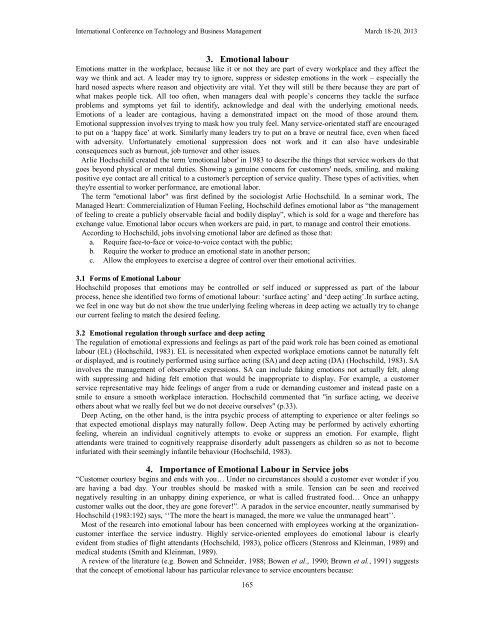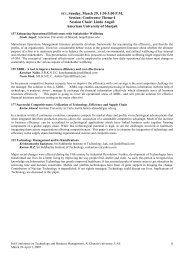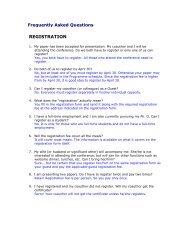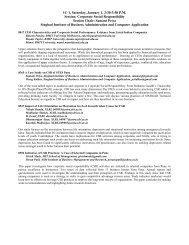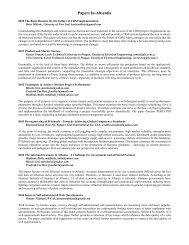Enormity of Emotional Labour and its Significance in the ... - Icmis.net
Enormity of Emotional Labour and its Significance in the ... - Icmis.net
Enormity of Emotional Labour and its Significance in the ... - Icmis.net
Create successful ePaper yourself
Turn your PDF publications into a flip-book with our unique Google optimized e-Paper software.
International Conference on Technology <strong>and</strong> Bus<strong>in</strong>ess Management March 18-20, 2013<br />
3. <strong>Emotional</strong> labour<br />
Emotions matter <strong>in</strong> <strong>the</strong> workplace, because like it or not <strong>the</strong>y are part <strong>of</strong> every workplace <strong>and</strong> <strong>the</strong>y affect <strong>the</strong><br />
way we th<strong>in</strong>k <strong>and</strong> act. A leader may try to ignore, suppress or sidestep emotions <strong>in</strong> <strong>the</strong> work – especially <strong>the</strong><br />
hard nosed aspects where reason <strong>and</strong> objectivity are vital. Yet <strong>the</strong>y will still be <strong>the</strong>re because <strong>the</strong>y are part <strong>of</strong><br />
what makes people tick. All too <strong>of</strong>ten, when managers deal with people’s concerns <strong>the</strong>y tackle <strong>the</strong> surface<br />
problems <strong>and</strong> symptoms yet fail to identify, acknowledge <strong>and</strong> deal with <strong>the</strong> underly<strong>in</strong>g emotional needs.<br />
Emotions <strong>of</strong> a leader are contagious, hav<strong>in</strong>g a demonstrated impact on <strong>the</strong> mood <strong>of</strong> those around <strong>the</strong>m.<br />
<strong>Emotional</strong> suppression <strong>in</strong>volves try<strong>in</strong>g to mask how you truly feel. Many service-orientated staff are encouraged<br />
to put on a ‘happy face’ at work. Similarly many leaders try to put on a brave or neutral face, even when faced<br />
with adversity. Unfortunately emotional suppression does not work <strong>and</strong> it can also have undesirable<br />
consequences such as burnout, job turnover <strong>and</strong> o<strong>the</strong>r issues.<br />
Arlie Hochschild created <strong>the</strong> term 'emotional labor' <strong>in</strong> 1983 to describe <strong>the</strong> th<strong>in</strong>gs that service workers do that<br />
goes beyond physical or mental duties. Show<strong>in</strong>g a genu<strong>in</strong>e concern for customers' needs, smil<strong>in</strong>g, <strong>and</strong> mak<strong>in</strong>g<br />
positive eye contact are all critical to a customer's perception <strong>of</strong> service quality. These types <strong>of</strong> activities, when<br />
<strong>the</strong>y're essential to worker performance, are emotional labor.<br />
The term "emotional labor" was first def<strong>in</strong>ed by <strong>the</strong> sociologist Arlie Hochschild. In a sem<strong>in</strong>ar work, The<br />
Managed Heart: Commercialization <strong>of</strong> Human Feel<strong>in</strong>g, Hochschild def<strong>in</strong>es emotional labor as “<strong>the</strong> management<br />
<strong>of</strong> feel<strong>in</strong>g to create a publicly observable facial <strong>and</strong> bodily display”, which is sold for a wage <strong>and</strong> <strong>the</strong>refore has<br />
exchange value. <strong>Emotional</strong> labor occurs when workers are paid, <strong>in</strong> part, to manage <strong>and</strong> control <strong>the</strong>ir emotions.<br />
Accord<strong>in</strong>g to Hochschild, jobs <strong>in</strong>volv<strong>in</strong>g emotional labor are def<strong>in</strong>ed as those that:<br />
a. Require face-to-face or voice-to-voice contact with <strong>the</strong> public;<br />
b. Require <strong>the</strong> worker to produce an emotional state <strong>in</strong> ano<strong>the</strong>r person;<br />
c. Allow <strong>the</strong> employees to exercise a degree <strong>of</strong> control over <strong>the</strong>ir emotional activities.<br />
3.1 Forms <strong>of</strong> <strong>Emotional</strong> <strong>Labour</strong><br />
Hochschild proposes that emotions may be controlled or self <strong>in</strong>duced or suppressed as part <strong>of</strong> <strong>the</strong> labour<br />
process, hence she identified two forms <strong>of</strong> emotional labour: ‘surface act<strong>in</strong>g’ <strong>and</strong> ‘deep act<strong>in</strong>g’.In surface act<strong>in</strong>g,<br />
we feel <strong>in</strong> one way but do not show <strong>the</strong> true underly<strong>in</strong>g feel<strong>in</strong>g whereas <strong>in</strong> deep act<strong>in</strong>g we actually try to change<br />
our current feel<strong>in</strong>g to match <strong>the</strong> desired feel<strong>in</strong>g.<br />
3.2 <strong>Emotional</strong> regulation through surface <strong>and</strong> deep act<strong>in</strong>g<br />
The regulation <strong>of</strong> emotional expressions <strong>and</strong> feel<strong>in</strong>gs as part <strong>of</strong> <strong>the</strong> paid work role has been co<strong>in</strong>ed as emotional<br />
labour (EL) (Hochschild, 1983). EL is necessitated when expected workplace emotions cannot be naturally felt<br />
or displayed, <strong>and</strong> is rout<strong>in</strong>ely performed us<strong>in</strong>g surface act<strong>in</strong>g (SA) <strong>and</strong> deep act<strong>in</strong>g (DA) (Hochschild, 1983). SA<br />
<strong>in</strong>volves <strong>the</strong> management <strong>of</strong> observable expressions. SA can <strong>in</strong>clude fak<strong>in</strong>g emotions not actually felt, along<br />
with suppress<strong>in</strong>g <strong>and</strong> hid<strong>in</strong>g felt emotion that would be <strong>in</strong>appropriate to display. For example, a customer<br />
service representative may hide feel<strong>in</strong>gs <strong>of</strong> anger from a rude or dem<strong>and</strong><strong>in</strong>g customer <strong>and</strong> <strong>in</strong>stead paste on a<br />
smile to ensure a smooth workplace <strong>in</strong>teraction. Hochschild commented that "<strong>in</strong> surface act<strong>in</strong>g, we deceive<br />
o<strong>the</strong>rs about what we really feel but we do not deceive ourselves" (p.33).<br />
Deep Act<strong>in</strong>g, on <strong>the</strong> o<strong>the</strong>r h<strong>and</strong>, is <strong>the</strong> <strong>in</strong>tra psychic process <strong>of</strong> attempt<strong>in</strong>g to experience or alter feel<strong>in</strong>gs so<br />
that expected emotional displays may naturally follow. Deep Act<strong>in</strong>g may be performed by actively exhort<strong>in</strong>g<br />
feel<strong>in</strong>g, where<strong>in</strong> an <strong>in</strong>dividual cognitively attempts to evoke or suppress an emotion. For example, flight<br />
attendants were tra<strong>in</strong>ed to cognitively reappraise disorderly adult passengers as children so as not to become<br />
<strong>in</strong>furiated with <strong>the</strong>ir seem<strong>in</strong>gly <strong>in</strong>fantile behaviour (Hochschild, 1983).<br />
4. Importance <strong>of</strong> <strong>Emotional</strong> <strong>Labour</strong> <strong>in</strong> Service jobs<br />
“Customer courtesy beg<strong>in</strong>s <strong>and</strong> ends with you… Under no circumstances should a customer ever wonder if you<br />
are hav<strong>in</strong>g a bad day. Your troubles should be masked with a smile. Tension can be seen <strong>and</strong> received<br />
negatively result<strong>in</strong>g <strong>in</strong> an unhappy d<strong>in</strong><strong>in</strong>g experience, or what is called frustrated food… Once an unhappy<br />
customer walks out <strong>the</strong> door, <strong>the</strong>y are gone forever!”. A paradox <strong>in</strong> <strong>the</strong> service encounter, neatly summarised by<br />
Hochschild (1983:192) says, ‘‘The more <strong>the</strong> heart is managed, <strong>the</strong> more we value <strong>the</strong> unmanaged heart’’.<br />
Most <strong>of</strong> <strong>the</strong> research <strong>in</strong>to emotional labour has been concerned with employees work<strong>in</strong>g at <strong>the</strong> organizationcustomer<br />
<strong>in</strong>terface <strong>the</strong> service <strong>in</strong>dustry. Highly service-oriented employees do emotional labour is clearly<br />
evident from studies <strong>of</strong> flight attendants (Hochschild, 1983), police <strong>of</strong>ficers (Stenross <strong>and</strong> Kle<strong>in</strong>man, 1989) <strong>and</strong><br />
medical students (Smith <strong>and</strong> Kle<strong>in</strong>man, 1989).<br />
A review <strong>of</strong> <strong>the</strong> literature (e.g. Bowen <strong>and</strong> Schneider, 1988; Bowen et al., 1990; Brown et al., 1991) suggests<br />
that <strong>the</strong> concept <strong>of</strong> emotional labour has particular relevance to service encounters because:<br />
165


